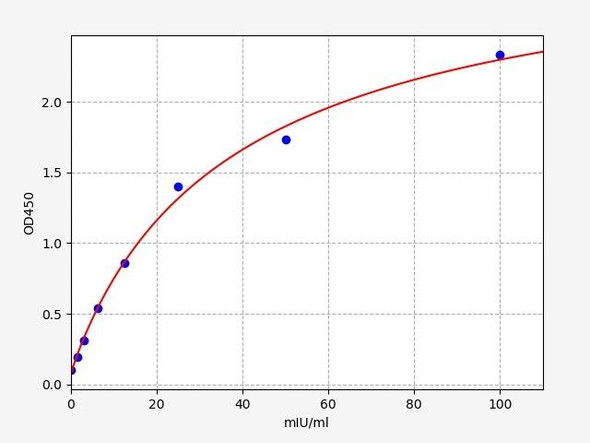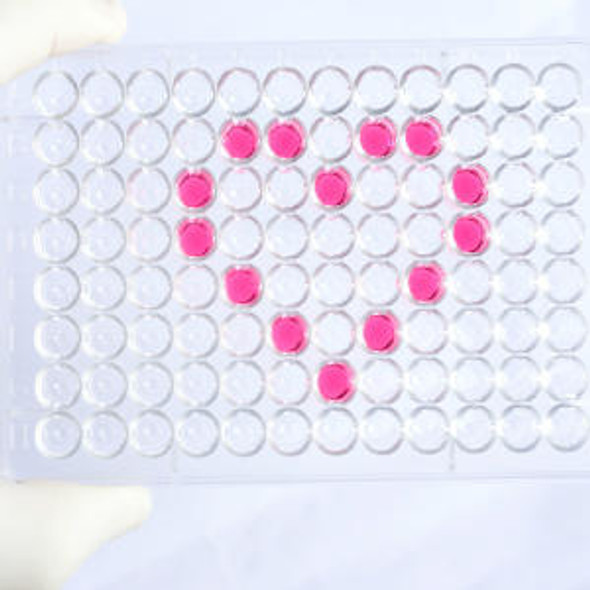Human Epigenetics and Nuclear Signaling ELISA Kits
Human THR alpha (Thyroid Hormone Receptor Alpha) CLIA Kit (HUES01258)
- SKU:
- HUES01258
- Product Type:
- ELISA Kit
- ELISA Type:
- CLIA Kit
- Size:
- 96 Assays
- Sensitivity:
- 9.38pg/mL
- Range:
- 15.63-1000pg/mL
- ELISA Type:
- Sandwich
- Reactivity:
- Human
- Sample Type:
- Serum, plasma and other biological fluids
- Research Area:
- Epigenetics and Nuclear Signaling
Description
| Assay type: | Sandwich |
| Format: | 96T |
| Assay time: | 4.5h |
| Reactivity: | Human |
| Detection method: | Chemiluminescence |
| Detection range: | 15.63-1000 pg/mL |
| Sensitivity: | 9.38 pg/mL |
| Sample volume: | 100µL |
| Sample type: | Serum, plasma and other biological fluids |
| Repeatability: | CV < 15% |
| Specificity: | This kit recognizes Human THR alpha in samples. No significant cross-reactivity or interference between Human THR alpha and analogues was observed. |
This kit uses Sandwich-CLIA as the method. The micro CLIA plate provided in this kit has been pre-coated with an antibody specific to Human THR alpha. Standards or samples are added to the appropriate micro CLIA plate wells and combined with the specific antibody. Then a biotinylated detection antibody specific for Human THR alpha and Avidin-Horseradish Peroxidase (HRP) conjugate are added to each micro plate well successively and incubated. Free components are washed away. The substrate solution is added to each well. Only those wells that contain Human THR alpha, biotinylated detection antibody and Avidin-HRP conjugate will appear fluorescence. The Relative light unit (RLU) value is measured spectrophotometrically by the Chemiluminescence immunoassay analyzer. The RLU value is positively associated with the concentration of Human THR alpha. The concentration of Human THR alpha in the samples can be calculated by comparing the RLU of the samples to the standard curve.
| UniProt Protein Function: | TR-alpha: nuclear hormone receptor and transcription factor. High affinity receptor for triiodothyronine. Interacts with SRC-3 and NCOA6 coactivators, leading to a strong increase of transcription of target genes. Four splice variant isoforms have been described. |
| UniProt Protein Details: | Protein type:DNA-binding; Nuclear receptor; Transcription factor Chromosomal Location of Human Ortholog: 17q11. 2 Cellular Component: nucleoplasm; cytosol; nucleus Molecular Function:protein domain specific binding; protein binding; zinc ion binding; sequence-specific DNA binding; TATA-binding protein binding; chromatin DNA binding; protein complex binding; steroid hormone receptor activity; thyroid hormone receptor activity; transcription factor activity; transcription factor binding Biological Process: transcription from RNA polymerase II promoter; transcription initiation from RNA polymerase II promoter; negative regulation of transcriptional preinitiation complex assembly; ossification; cytoplasmic sequestering of transcription factor; intracellular receptor-mediated signaling pathway; hormone-mediated signaling; positive regulation of female receptivity; regulation of myeloid cell apoptosis; regulation of lipid catabolic process; regulation of heart contraction; regulation of transcription from RNA polymerase II promoter; female courtship behavior; learning and/or memory; thyroid gland development; erythrocyte differentiation; steroid hormone mediated signaling; gene expression; positive regulation of transcription from RNA polymerase II promoter; response to cold; negative regulation of transcription, DNA-dependent; cartilage condensation Disease: Hypothyroidism, Congenital, Nongoitrous, 6 |
| NCBI Summary: | The protein encoded by this gene is a nuclear hormone receptor for triiodothyronine. It is one of the several receptors for thyroid hormone, and has been shown to mediate the biological activities of thyroid hormone. Knockout studies in mice suggest that the different receptors, while having certain extent of redundancy, may mediate different functions of thyroid hormone. Alternatively spliced transcript variants encoding distinct isoforms have been reported. [provided by RefSeq, Jul 2008] |
| UniProt Code: | P10827 |
| NCBI GenInfo Identifier: | 135705 |
| NCBI Gene ID: | 7067 |
| NCBI Accession: | P10827. 1 |
| UniProt Secondary Accession: | P10827,P21205, Q8N6A1, Q96H73, A8K3B5, |
| UniProt Related Accession: | P10827 |
| Molecular Weight: | 50,465 Da |
| NCBI Full Name: | Thyroid hormone receptor alpha |
| NCBI Synonym Full Names: | thyroid hormone receptor, alpha |
| NCBI Official Symbol: | THRA |
| NCBI Official Synonym Symbols: | AR7; EAR7; ERBA; CHNG6; ERBA1; NR1A1; THRA1; THRA2; ERB-T-1; c-ERBA-1 |
| NCBI Protein Information: | thyroid hormone receptor alpha; EAR-7; c-erbA-alpha; ERBA-related 7; V-erbA-related protein 7; triiodothyronine receptor; nuclear receptor subfamily 1 group A member 1; thyroid normone nuclear receptor alpha variant 1; thyroid hormone receptor, alpha (erythroblastic leukemia viral (v-erb-a) oncogene homolog, avian) |
| UniProt Protein Name: | Thyroid hormone receptor alpha |
| UniProt Synonym Protein Names: | Nuclear receptor subfamily 1 group A member 1; V-erbA-related protein 7; EAR-7; c-erbA-1; c-erbA-alpha |
| Protein Family: | Thyroid hormone receptor |
| UniProt Gene Name: | THRA |
| UniProt Entry Name: | THA_HUMAN |
As the RLU values of the standard curve may vary according to the conditions of the actual assay performance (e. g. operator, pipetting technique, washing technique or temperature effects), the operator should establish a standard curve for each test. Typical standard curve and data is provided below for reference only.
| Concentration (pg/mL) | RLU | Average | Corrected |
| 1000 | 49952 57398 | 53675 | 53650 |
| 500 | 21508 23470 | 22489 | 22464 |
| 250 | 10312 10110 | 10211 | 10186 |
| 125 | 4635 5167 | 4901 | 4876 |
| 62.5 | 2543 2363 | 2453 | 2428 |
| 31.25 | 1362 1200 | 1281 | 1256 |
| 15.63 | 677 739 | 708 | 683 |
| 0 | 24 26 | 25 | -- |
Precision
Intra-assay Precision (Precision within an assay): 3 samples with low, mid range and high level Human THR alpha were tested 20 times on one plate, respectively.
Inter-assay Precision (Precision between assays): 3 samples with low, mid range and high level Human THR alpha were tested on 3 different plates, 20 replicates in each plate.
| Intra-assay Precision | Inter-assay Precision | |||||
| Sample | 1 | 2 | 3 | 1 | 2 | 3 |
| n | 20 | 20 | 20 | 20 | 20 | 20 |
| Mean (pg/mL) | 47.34 | 91.68 | 364.58 | 51.82 | 83.21 | 342.81 |
| Standard deviation | 4.38 | 8.67 | 28.66 | 6.71 | 7.26 | 36.99 |
| C V (%) | 9.25 | 9.46 | 7.86 | 12.95 | 8.72 | 10.79 |
Recovery
The recovery of Human THR alpha spiked at three different levels in samples throughout the range of the assay was evaluated in various matrices.
| Sample Type | Range (%) | Average Recovery (%) |
| Serum (n=5) | 85-98 | 92 |
| EDTA plasma (n=5) | 93-104 | 98 |
| Cell culture media (n=5) | 95-112 | 103 |
Linearity
Samples were spiked with high concentrations of Human THR alpha and diluted with Reference Standard & Sample Diluent to produce samples with values within the range of the assay.
| Serum (n=5) | EDTA plasma (n=5) | Cell culture media (n=5) | ||
| 1:2 | Range (%) | 97-110 | 86-98 | 88-101 |
| Average (%) | 105 | 92 | 95 | |
| 1:4 | Range (%) | 93-110 | 98-114 | 97-111 |
| Average (%) | 100 | 105 | 104 | |
| 1:8 | Range (%) | 96-110 | 99-114 | 94-106 |
| Average (%) | 102 | 106 | 101 | |
| 1:16 | Range (%) | 85-100 | 88-103 | 101-117 |
| Average (%) | 91 | 95 | 108 |
An unopened kit can be stored at 4°C for 1 month. If the kit is not used within 1 month, store the items separately according to the following conditions once the kit is received.
| Item | Specifications | Storage |
| Micro CLIA Plate(Dismountable) | 8 wells ×12 strips | -20°C, 6 months |
| Reference Standard | 2 vials | |
| Concentrated Biotinylated Detection Ab (100×) | 1 vial, 120 µL | |
| Concentrated HRP Conjugate (100×) | 1 vial, 120 µL | -20°C(shading light), 6 months |
| Reference Standard & Sample Diluent | 1 vial, 20 mL | 4°C, 6 months |
| Biotinylated Detection Ab Diluent | 1 vial, 14 mL | |
| HRP Conjugate Diluent | 1 vial, 14 mL | |
| Concentrated Wash Buffer (25×) | 1 vial, 30 mL | |
| Substrate Reagent A | 1 vial, 5 mL | 4°C (shading light) |
| Substrate Reagent B | 1 vial, 5 mL | 4°C (shading light) |
| Plate Sealer | 5 pieces | |
| Product Description | 1 copy | |
| Certificate of Analysis | 1 copy |
- Set standard, test sample and control (zero) wells on the pre-coated plate and record theirpositions. It is recommended to measure each standard and sample in duplicate. Note: addall solutions to the bottom of the plate wells while avoiding contact with the well walls. Ensuresolutions do not foam when adding to the wells.
- Aliquot 100 µL of standard solutions into the standard wells.
- Add 100 µL of Sample / Standard dilution buffer into the control (zero) well.
- Add 100 µL of properly diluted sample (serum, plasma, tissue homogenates and otherbiological fluids. ) into test sample wells.
- Cover the plate with the sealer provided in the kit and incubate for 90 min at 37 °C.
- Aspirate the liquid from each well, do not wash. Immediately add 100 µL of BiotinylatedDetection Ab working solution to each well. Cover the plate with a plate seal and gently mix. Incubate for 1 hour at 37 °C.
- Aspirate or decant the solution from the plate and add 350 µL of wash buffer to each welland incubate for 1-2 minutes at room temperature. Aspirate the solution from each well andclap the plate on absorbent filter paper to dry. Repeat this process 3 times. Note: a microplatewasher can be used in this step and other wash steps.
- Add 100 µL of HRP Conjugate working solution to each well. Cover with a plate seal andincubate for 30 min at 37 °C.
- Aspirate or decant the solution from each well. Repeat the wash process for five times asconducted in step 7.
- Add 100 µL of Substrate mixture solution to each well. Cover with a new plate seal andincubate for no more than 5 min at 37 °C. Protect the plate from light.
- Determine the RLU value of each well immediately.






